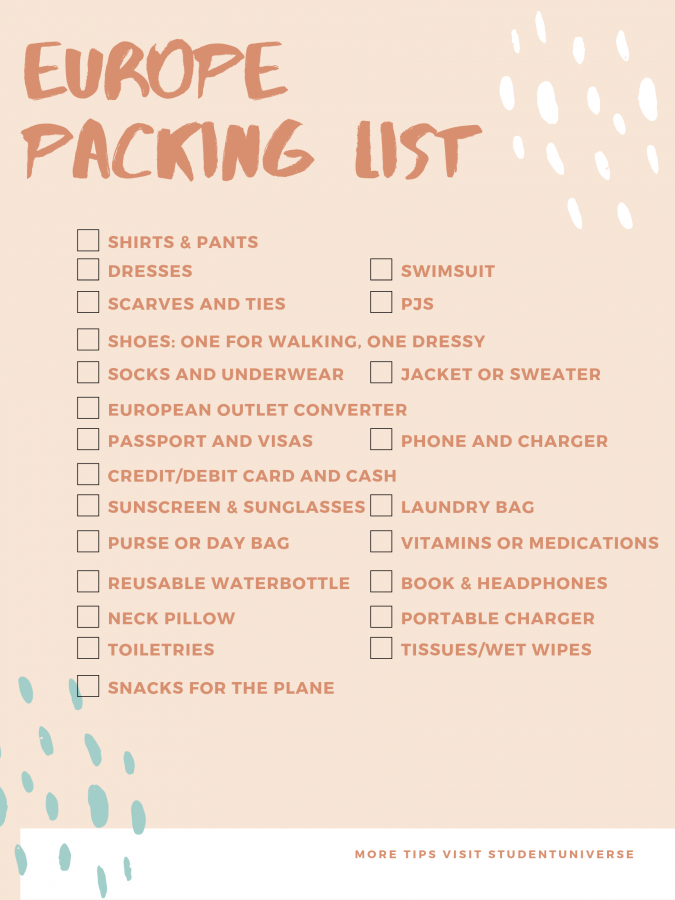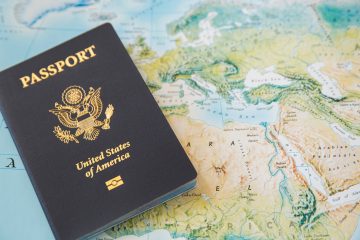Heading to Europe this summer or next semester for study abroad? Lucky you! Now your only problem is trying to figure out your Europe packing list. Thankfully, we’ve got you covered with our ultimate guide to packing for your trip to Europe.
Want a checklist to make sure you’ve got it all? Save our handy Europe packing list to use while you prepare, and scroll down for more tips and details.

Clothes
Europeans are known for their fashion sense, but you don’t have to be a fashionista to look great on your European adventure. Just stick to some easy basics that will be classy and comfortable for your trip. The easiest way to pack is to find clothes that will all be able to mix and match together, so you can bring the largest number of possible outfits with the fewest pieces. Pro tip: you’ll need less than you think you will! We recommend:

- Shirts. 4-5 is enough! If you’re going to be away for more than a few weeks, you can do some laundry.
- Bottoms: skirts/pants/nice jeans are good. One or two pairs of shorts is great for hot summer days (although you won’t see many Europeans wearing shorts, even when it’s really hot, except at the beach).
- Dresses: an ideal traveling outfit for Europe, since they don’t take up much space and can easily be dressed up or down.
- Ties/scarves: great way to spice up your outfit. (Scarves can also make an ideal sweater, blanket, towel, swimsuit cover-up, etc.)
- Shoes: bring a pair of shoes that’s great for walking and a pair that’s a bit fancier. Avoid bringing heels since many of the streets are cobblestone or otherwise quite uneven. You’ll see locals walking around with heels like a champ, but for the rest of us, they can be ankle-wreckers for sure. For summer, a nice pair of sneakers and a pair of sandals is a great bet. For winter, go for boots.
- Jackets: a few nice sweaters handy for cool nights.
- Socks and underwear. Obvs.
- Swimsuit. Because what’s a summer in Europe without a trip to the beach?
- PJs and loungewear.
Toiletries
The main mistake people make when packing toiletries is packing too many! Keep in mind that you don’t have to bring every item you own, just what you absolutely need on a daily basis. Not sure what you need? Set out a bag in your bathroom a day or two before your trip and when you use an item, dump it in the bag. Then you’ll be sure to bring only what you’ve regularly used!
Buying small travel containers of your favorite products (or better yet, reusable travel-sized containers you can fill yourself) will save you tons of space in your luggage as well. Also be sure not to forget any medications or vitamins you may need.
Electronics
When traveling, it’s usually best to err on the side of caution and bring as few valuables as possible. Which electronics do you really need and which can you leave behind? The fewer you have to drag around, the better.

Don’t forget all the chargers and necessary pieces, good cases and outlet converters. An outlet converter is a must on your Europe packing list! This is a cheap but reliable outlet converter we like that has lasted through a half-dozen international trips (and is still going strong!) A small, portable phone charger can also be a life-saver, especially if you think you’ll be using your phone for lots of photos, using Google Maps, etc.
Data
Before you go, make sure your phone is all set for your trip! If you’re staying abroad for several months, it might be a good idea to purchase a SIM card abroad. If you’re traveling for a shorter amount of time, you can look into what international data plans your regular provider offers. Whatever you do, make sure you get it set up before you leave or be sure to turn off roaming data before you land to avoid getting hit with expensive international charges.
Money
You’ll definitely need it, but how should you bring it? Most credit or debit cards with a chip can be used in Europe (especially Visa cards). Be sure to check in advance what international transaction or currency charges there are, since they can vary widely. If you’re planning on using a card abroad, make sure you call your bank or credit card company in advance as well to let them know the dates and countries you’ll be traveling to. If you don’t, they may mark your transactions as fraud and block your card.

It’s also a good idea to have some emergency cash in US dollars. You’ll also want to have some cash in the local currency as well, especially for small transactions and local businesses that may not accept cards. You can order euros (or other currencies) before you go from a local bank in the US or get cash from an ATM in Europe. (Avoid currency-changing banks and kiosks, especially in airports, train stations and around tourist hotspots—you won’t get the best exchange rate!)
Travel Documents
In the digital age, packing travel documents is pretty easy since most of them live online or on your phone! That being said, if you forget your passport or any visas you may need, your trip will be off to a rough start. Always check in advance if you need any additional visas or documents for the countries you’ll be visiting.
For US citizens, if you’re traveling to the U.K. or one of the 26 countries in the Schengen region, your passport is all you need (as long as you’re traveling only as a tourist and staying for less than 90 days). Starting in 2021, you’ll need an additional visa, but you can read all about the new requirements for European travel here.
For during the day

Bringing a day bag for going out will make your life so much easier. A cross-body bag is a great option, especially for girls, and helps keep your stuff close to you to deter pickpockets. A small backpack is also a good option (just don’t keep any valuables in the small front pockets, which can be easily opened without you noticing). A small passport or money pouch, a reusable water bottle, a journal, chapstick and sunscreen, portable chargers and a bit of cash are all great items to add to your packing list to have on hand during the day.
Forgetting anything?
Aside from the obvious, there’s probably some small things you might be forgetting to bring with you that can be super helpful. If you’re staying in hostels, don’t forget a pair of flip-flops for the shower as well as a flashlight (especially if you’re sneaking into your bed late at night). The flashlight on your phone can work well but it always helps to have an extra on hand, just in case. Bringing a bag for laundry and wet clothing items definitely helps keep everything fresh in your suitcase (I just bring an extra pillowcase to use for this).
Don’t forget all the other little things you usually need on a daily basis! A good book and a few downloaded movies, TV shows, podcasts, etc. will be a life-saver on long flights and train rides. It can be a good idea to bring a basic first-aid kit with Advil, cold/allergy relievers, bandaids and etc. Of course, you can easily find a pharmacy to get the equivalent things in Europe should you end up needing them, but I find it’s easier to just have my own.
Need some inspiration as you plan? Follow us on Instagram for inspo on the daily.

